2022 HYUNDAI VELOSTER tire size
[x] Cancel search: tire sizePage 130 of 446
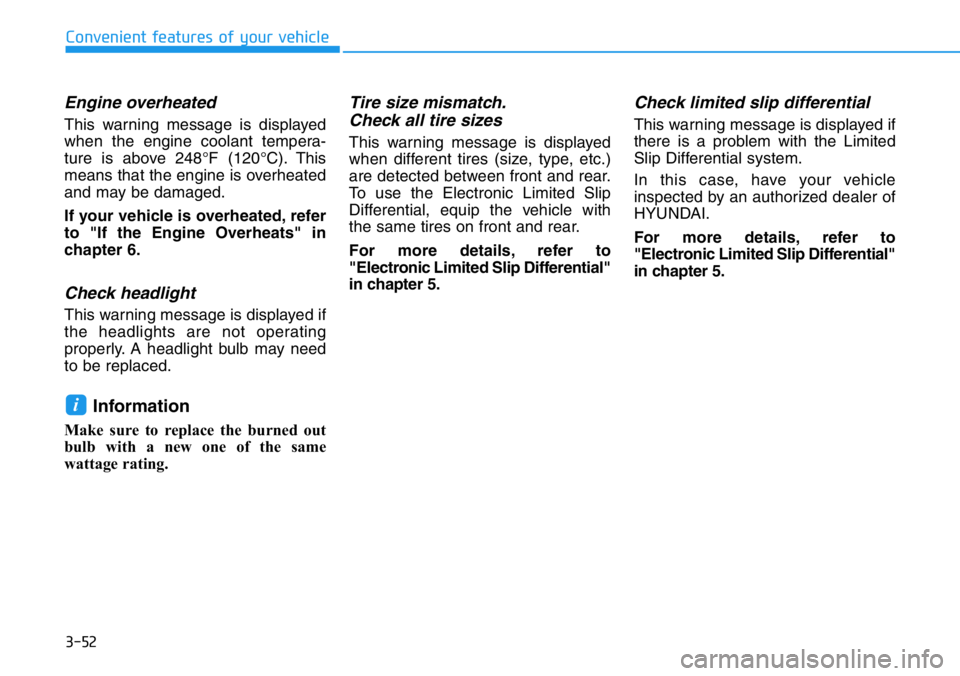
3-52
Convenient features of your vehicle
Engine overheated
This warning message is displayed
when the engine coolant tempera-
ture is above 248°F (120°C). This
means that the engine is overheated
and may be damaged.
If your vehicle is overheated, refer
to "If the Engine Overheats" in
chapter 6.
Check headlight
This warning message is displayed if
the headlights are not operating
properly. A headlight bulb may need
to be replaced.
Information
Make sure to replace the burned out
bulb with a new one of the same
wattage rating.
Tire size mismatch.
Check all tire sizes
This warning message is displayed
when different tires (size, type, etc.)
are detected between front and rear.
To use the Electronic Limited Slip
Differential, equip the vehicle with
the same tires on front and rear.
For more details, refer to
"Electronic Limited Slip Differential"
in chapter 5.
Check limited slip differential
This warning message is displayed if
there is a problem with the Limited
Slip Differential system.
In this case, have your vehicle
inspected by an authorized dealer of
HYUNDAI.
For more details, refer to
"Electronic Limited Slip Differential"
in chapter 5.
i
Page 234 of 446
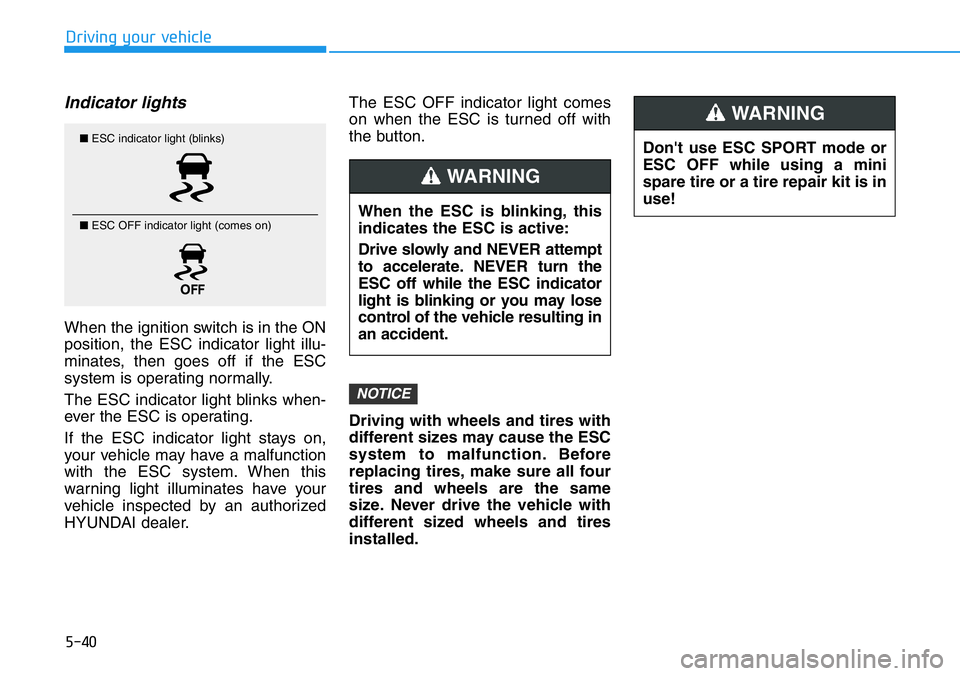
5-40
Driving your vehicle
Indicator lights
When the ignition switch is in the ON
position, the ESC indicator light illu-
minates, then goes off if the ESC
system is operating normally.
The ESC indicator light blinks when-
ever the ESC is operating.
If the ESC indicator light stays on,
your vehicle may have a malfunction
with the ESC system. When this
warning light illuminates have your
vehicle inspected by an authorized
HYUNDAI dealer.The ESC OFF indicator light comes
on when the ESC is turned off with
the button.
Driving with wheels and tires with
different sizes may cause the ESC
system to malfunction. Before
replacing tires, make sure all four
tires and wheels are the same
size. Never drive the vehicle with
different sized wheels and tires
installed.
NOTICE
Don't use ESC SPORT mode or
ESC OFF while using a mini
spare tire or a tire repair kit is in
use!
WARNING
When the ESC is blinking, this
indicates the ESC is active:
Drive slowly and NEVER attempt
to accelerate. NEVER turn the
ESC off while the ESC indicator
light is blinking or you may lose
control of the vehicle resulting in
an accident.
WARNING
■ESC indicator light (blinks)
■ ESC OFF indicator light (comes on)
Page 237 of 446
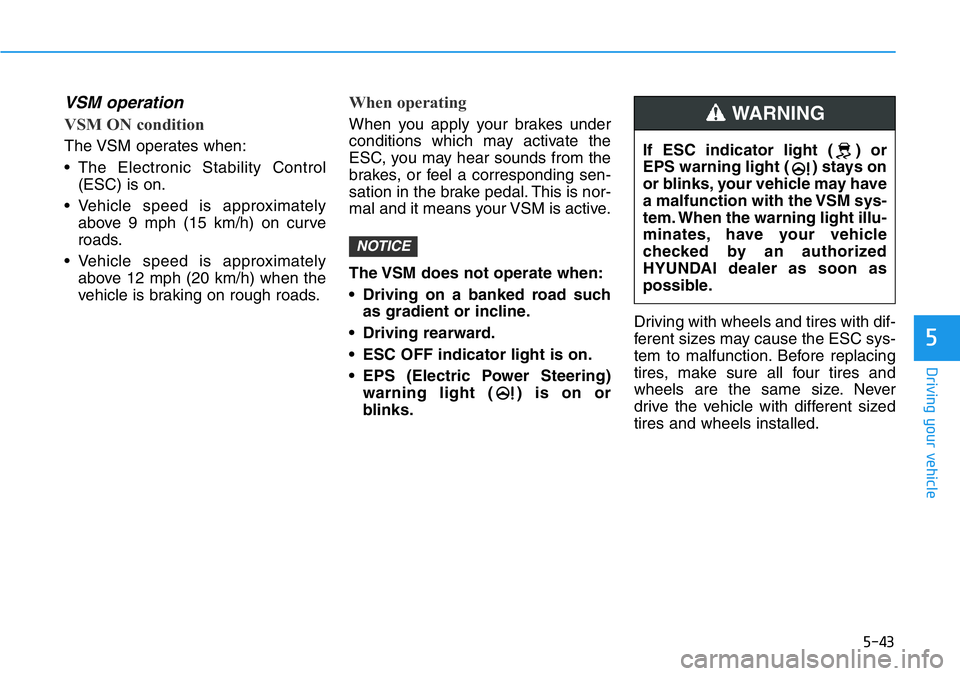
5-43
Driving your vehicle
5
VSM operation
VSM ON condition
The VSM operates when:
• The Electronic Stability Control
(ESC) is on.
• Vehicle speed is approximately
above 9 mph (15 km/h) on curve
roads.
• Vehicle speed is approximately
above 12 mph (20 km/h) when the
vehicle is braking on rough roads.
When operating
When you apply your brakes under
conditions which may activate the
ESC, you may hear sounds from the
brakes, or feel a corresponding sen-
sation in the brake pedal. This is nor-
mal and it means your VSM is active.
The VSM does not operate when:
• Driving on a banked road such
as gradient or incline.
• Driving rearward.
• ESC OFF indicator light is on.
• EPS (Electric Power Steering)
warning light ( ) is on or
blinks.Driving with wheels and tires with dif-
ferent sizes may cause the ESC sys-
tem to malfunction. Before replacing
tires, make sure all four tires and
wheels are the same size. Never
drive the vehicle with different sized
tires and wheels installed.
NOTICE
If ESC indicator light ( ) or
EPS warning light ( ) stays on
or blinks, your vehicle may have
a malfunction with the VSM sys-
tem. When the warning light illu-
minates, have your vehicle
checked by an authorized
HYUNDAI dealer as soon as
possible.
WARNING
Page 242 of 446
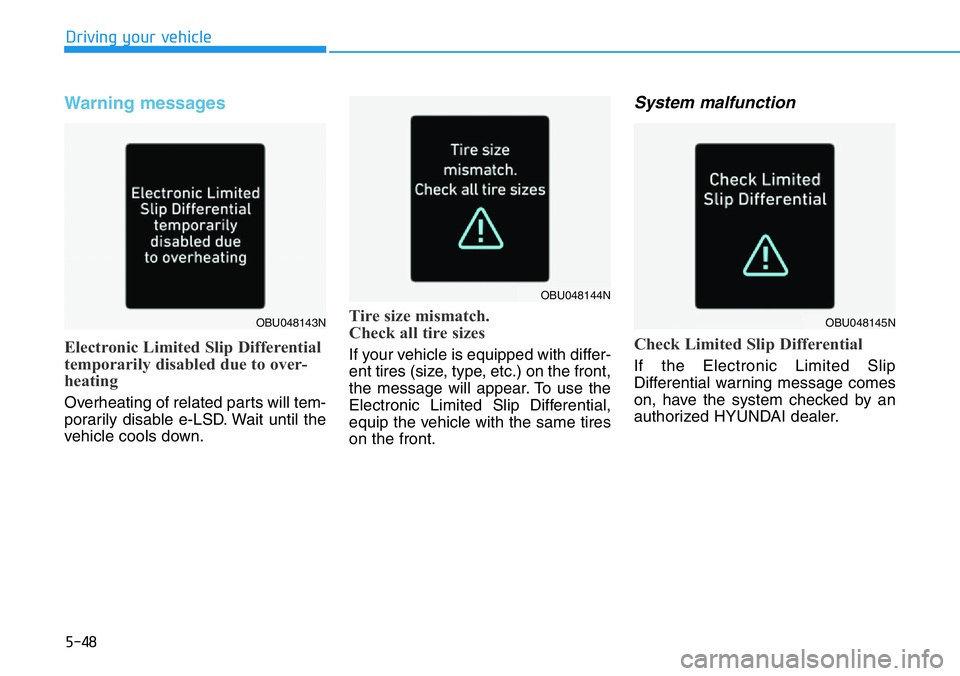
5-48
Driving your vehicle
Warning messages
Electronic Limited Slip Differential
temporarily disabled due to over-
heating
Overheating of related parts will tem-
porarily disable e-LSD. Wait until the
vehicle cools down.
Tire size mismatch.
Check all tire sizes
If your vehicle is equipped with differ-
ent tires (size, type, etc.) on the front,
the message will appear. To use the
Electronic Limited Slip Differential,
equip the vehicle with the same tires
on the front.
System malfunction
Check Limited Slip Differential
If the Electronic Limited Slip
Differential warning message comes
on, have the system checked by an
authorized HYUNDAI dealer.
OBU048143N
OBU048144N
OBU048145N
Page 317 of 446

5-123
Driving your vehicle
5
WINTER DRIVING
The severe weather conditions of
winter quickly wear out tires and
cause other problems. To minimize
winter driving problems, you should
take the following suggestions:
Snow or Icy Conditions
You need to keep sufficient distance
between your vehicle and the vehicle
in front of you.
Apply the brakes gently. Speeding,
rapid acceleration, sudden brake
applications, and sharp turns are
potentially very hazardous practices.
During deceleration, use engine
braking to the fullest extent. Sudden
brake applications on snowy or icy
roads may cause the vehicle to skid.
To drive your vehicle in deep snow, it
may be necessary to use snow tires
or to install tire chains on your tires.
Always carry emergency equipment.
Some of the items you may want to
carry include tire chains, tow straps
or chains, a flashlight, emergency
flares, sand, a shovel, jumper cables,
a window scraper, gloves, ground
cloth, coveralls, a blanket, etc.
Snow tires
Standard tire Recommended snow tire
Tire sizeWheel sizeTire sizeWheel size
225/40ZR18 7.5Jx18
225/40R18 7.5Jx18
235/35R19 8.0Jx19
We recommend you use snow tires when road temperature is below 45°F
(7°C). Refer to the below chart, and mount the recommended snow tire for
your vehicle.
If you mount snow tires on your vehicle, make sure to use the same inflation
pressure as the original tires. Mount snow tires on all four wheels to balance
your vehicle's handling in all weather conditions. The traction provided by
snow tires on dry road may not be as high as your vehicle's original equip-
ment tires. Check with the tire dealer for maximum speed recommendations.
Information
Do not install studded tires without first checking local, state and municipal reg-
ulations for possible restrictions against their use.
i
Page 318 of 446
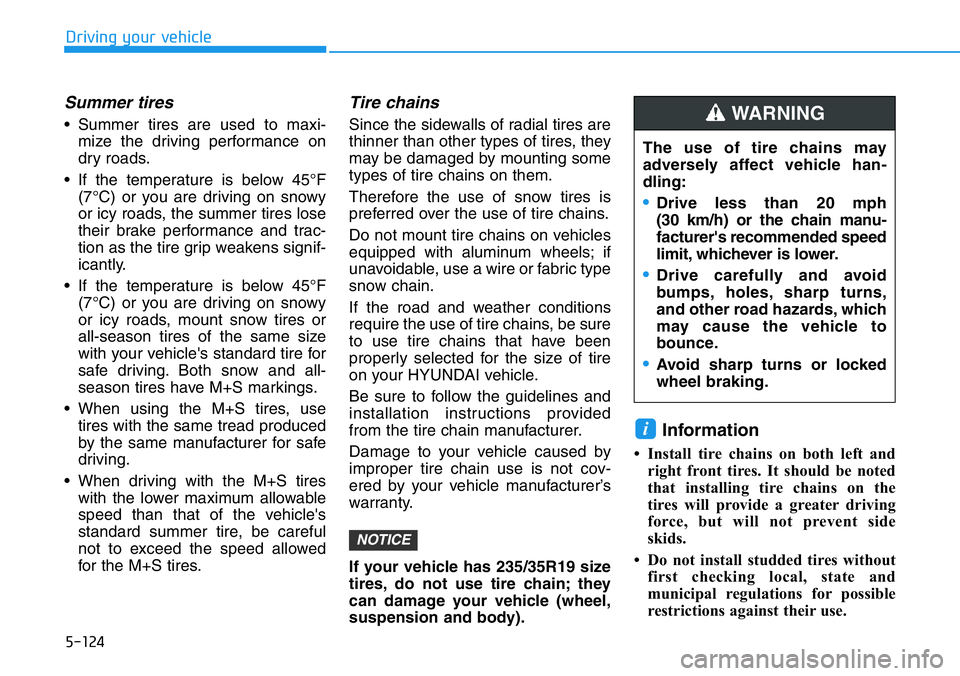
5-124
Driving your vehicle
Summer tires
• Summer tires are used to maxi-
mize the driving performance on
dry roads.
• If the temperature is below 45°F
(7°C) or you are driving on snowy
or icy roads, the summer tires lose
their brake performance and trac-
tion as the tire grip weakens signif-
icantly.
• If the temperature is below 45°F
(7°C) or you are driving on snowy
or icy roads, mount snow tires or
all-season tires of the same size
with your vehicle's standard tire for
safe driving. Both snow and all-
season tires have M+S markings.
• When using the M+S tires, use
tires with the same tread produced
by the same manufacturer for safe
driving.
• When driving with the M+S tires
with the lower maximum allowable
speed than that of the vehicle's
standard summer tire, be careful
not to exceed the speed allowed
for the M+S tires.
Tire chains
Since the sidewalls of radial tires are
thinner than other types of tires, they
may be damaged by mounting some
types of tire chains on them.
Therefore the use of snow tires is
preferred over the use of tire chains.
Do not mount tire chains on vehicles
equipped with aluminum wheels; if
unavoidable, use a wire or fabric type
snow chain.
If the road and weather conditions
require the use of tire chains, be sure
to use tire chains that have been
properly selected for the size of tire
on your HYUNDAI vehicle.
Be sure to follow the guidelines and
installation instructions provided
from the tire chain manufacturer.
Damage to your vehicle caused by
improper tire chain use is not cov-
ered by your vehicle manufacturer’s
warranty.
If your vehicle has 235/35R19 size
tires, do not use tire chain; they
can damage your vehicle (wheel,
suspension and body).
Information
• Install tire chains on both left and
right front tires. It should be noted
that installing tire chains on the
tires will provide a greater driving
force, but will not prevent side
skids.
• Do not install studded tires without
first checking local, state and
municipal regulations for possible
restrictions against their use.
i
NOTICE
The use of tire chains may
adversely affect vehicle han-
dling:
•Drive less than 20 mph
(30 km/h) or the chain manu-
facturer's recommended speed
limit, whichever is lower.
•Drive carefully and avoid
bumps, holes, sharp turns,
and other road hazards, which
may cause the vehicle to
bounce.
•Avoid sharp turns or locked
wheel braking.
WARNING
Page 319 of 446
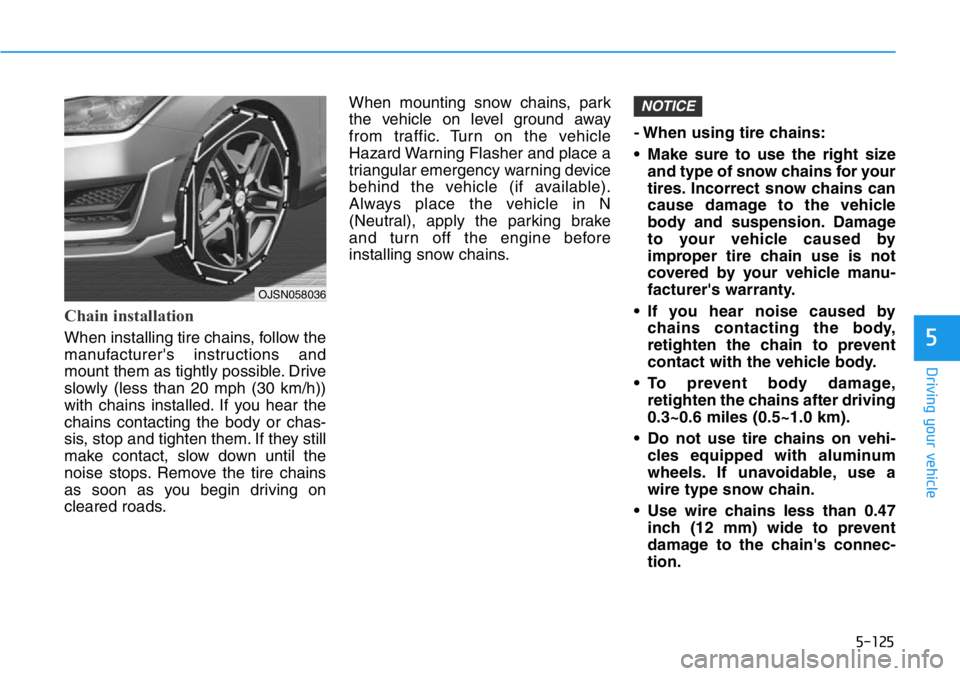
5-125
Driving your vehicle
5
Chain installation
When installing tire chains, follow the
manufacturer's instructions and
mount them as tightly possible. Drive
slowly (less than 20 mph (30 km/h))
with chains installed. If you hear the
chains contacting the body or chas-
sis, stop and tighten them. If they still
make contact, slow down until the
noise stops. Remove the tire chains
as soon as you begin driving on
cleared roads.When mounting snow chains, park
the vehicle on level ground away
from traffic. Turn on the vehicle
Hazard Warning Flasher and place a
triangular emergency warning device
behind the vehicle (if available).
Always place the vehicle in N
(Neutral), apply the parking brake
and turn off the engine before
installing snow chains.- When using tire chains:
• Make sure to use the right size
and type of snow chains for your
tires. Incorrect snow chains can
cause damage to the vehicle
body and suspension. Damage
to your vehicle caused by
improper tire chain use is not
covered by your vehicle manu-
facturer's warranty.
• If you hear noise caused by
chains contacting the body,
retighten the chain to prevent
contact with the vehicle body.
• To prevent body damage,
retighten the chains after driving
0.3~0.6 miles (0.5~1.0 km).
• Do not use tire chains on vehi-
cles equipped with aluminum
wheels. If unavoidable, use a
wire type snow chain.
• Use wire chains less than 0.47
inch (12 mm) wide to prevent
damage to the chain's connec-
tion.
NOTICE
OJSN058036
Page 323 of 446
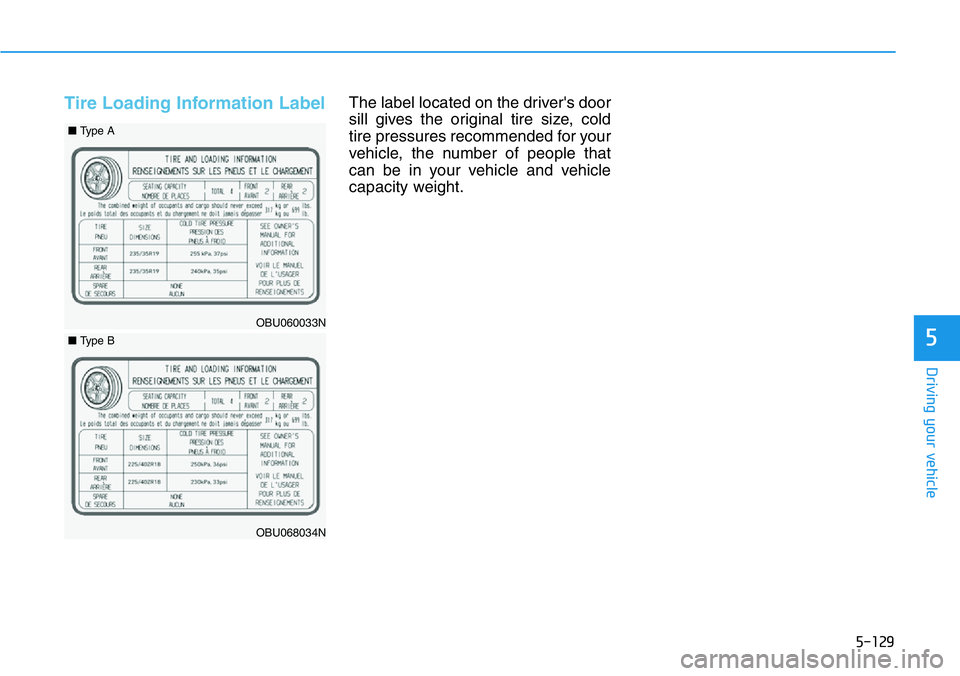
5-129
Driving your vehicle
5
Tire Loading Information LabelThe label located on the driver's door
sill gives the original tire size, cold
tire pressures recommended for your
vehicle, the number of people that
can be in your vehicle and vehicle
capacity weight.
OBU060033N
■Type A
OBU068034N
■Type B